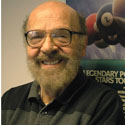 Tips & shafts By George Fels Consulting Editor George Fels has been writing for Billiards Digest since 1980, and his "Tips & Shafts" column is usually our readers' first stop when they crack open the magazine. For better or worse, pool has been his only mistress for 40-plus years.
Archives
Best of Fels
|
|
March: The Other Side of the Hill March 2009 ONE OF the first applause-worthy aspects of southern Indiana's Horseshoe Casino, the new venue for pool's joyous Derby City Classic, is that it allows the game to be viewed from above. And there may be no better view, especially to watch banks, pool's most geometrical form by far. Obviously there isn't the same chance to check out the players' nuances, but you see bank pool itself much more clearly, with all its natural angles as well as those that the game demands the players alter.
9-Ball banks, the pool sub-specie offered at the DCC (and nowhere else), looks to the untrained eye to be the game's version of wham-bam-thank you-ma'am. But it's far subtler than that, and its best competitors select two-way shots - those marrying offense with defense- whenever possible, just as they would in conventional banks or one-pocket. They also understand that banks has another quality making it unique besides its geometry: it's the only pool form where the successful pocketing of a ball depends not only on accuracy, but the speed (or lack thereof) with which it was struck.
Bank pool, then, like blitz chess and concentration gin rummy, is pretty much for experts only. The catch is that in the mid-south, home to the DCC, bank pool is learned shortly after potty training, and there are scores of players you never heard of who can still flay your fanny for you. Cream does rise in the game; the annual (and more than a bit silly) ring banks game pretty much brings out the same half-dozen players each year, and this year's formal banks competition crowned perennial runner-up (and ultimate 2009 all-around champion) John Brumback. But each year, in all three of the DCC's competitive forums, there is still no single player who attracts anywhere near as much attention as Efren Reyes.
Efren does not visit the U. S. very often anymore. He has fathered children with any number of women, one of whom he has finally deigned to marry; he is said to have visa problems anyhow; and besides, the tournament prizes for which he can compete in Asia are many times the multiple of those offered here. It's fair to say he attends this event, in which he has won the prestigious Master of the Table title three times - a remarkable achievement, in that he conquered fields largely comprising all the great players in the world - not for its lukewarm purses but for what he can win in after-hours play.
Ever since we learned he was not Cesar Morales (the pseudonym he used, for no apparent reason, in his American debut in Houston in the mid-'80s), Efren has enjoyed the same kind of single-name identity that Kobe, LeBron and Tiger have posted in other sports. His home nation, the Philippines, has already honored him as one of their 10 greatest athletes of all time, which ironically helps explain why his fellow Filipinos are so mighty at pool. The list on which Efren appears is made up mostly of bantamweight and flyweight boxers, plus one world-class bowler. From a genetics standpoint, Filipinos are generally neither very big nor very strong. Even in Asian sport staples such as martial arts and table tennis, they lag behind other countries. In short, there aren't a lot of places in sports they can go; add to that their insatiable love of gambling, plus the unspeakable poverty from which most of them have emerged, and you have a near-perfect foundation for serious pool playing.
And none has gone further than Efren Reyes, quite possibly the least-likely looking athlete in the history of sports. His famous serpentine stroke has even been analyzed and dissected on YouTube. What that examination proves has already been demonstrated by such sporting mavericks as golf's Lee Trevino and baseball's immortal Roberto Clemente: As long as the striking instrument is delivered to the ball in perfect position at the precise moment of impact, the striker can create just about any kind of prelude s/he likes.
The difference in the way the balls behave for Efren these days isn't easy to detect, but it's still there. The single factor most responsible for his being so dominant over the last quarter-century is not that he can score from anywhere; all of today's top players can do that. But Efren has always been able to score from anywhere in more ways than his competition, and that's what seems to be slipping. It's been long conjectured that if he can be had at any cue game, it's at bank pool. Sometimes the difference can be as simple as his sinking a ball in the less desirable half of a pocket. But he's gone somewhat soggy, at least by his standards, and it's not just in bank pool.
He rarely ran more than two playing tournament banks. He performed indifferently in blowing four barrels playing "one and one" (alternating games of banks and one-pocket) to Indiana's spectacular shot maker Mark Jarvis, competing without spot. And while he lost a fairly close $20,000 10-ball challenge match (23-18) to Shane Van Boening, he still wasn't quite the same player we're used to seeing. He's roughly 55; his refusal to wear his false teeth not only makes him seem older, but threatens his health. Ronnie Alcano and other top Filipinos play him even up now; there is even one (Dennis Orcollo) with whom he will not gamble any more.
And yet he still executes remarkable shots; he still holds a marked edge, and even wins entire matches, over anyone who simply cannot forget that it's Efren whom he's playing against. He remains the only player in the history of one-pocket who was a full two balls over the rest of the playing universe (he gives Cliff Joyner 9-7; everybody else wants more). And with the wealth of today's playing ability, he may well be the last player we'll see who was unanimously perceived as the best in the world.
Instead, the unanimous Players of the Decade for the '90s will likely be forced to wait until 2010 and hopefully no longer.
|





